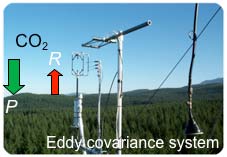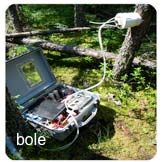The concentration of atmospheric carbon dioxide (CO2), a major greenhouse gas, continues to climb primarily due to the combustion of fossil fuels. Terrestrial ecosystems remove CO2 from the atmosphere through the photosynthetic activity of plants and trees and release CO2 to the atmosphere through respiration. Whether the global biosphere mitigates or exacerbates the growth rate of atmospheric CO2 will depend on the individual responses of photosynthesis and respiration to changing climate.





Biometeorologists measure the difference between photosynthesis and respiration (net ecosystem productivity, or NEP) at the ecosystem level above the canopy using a technique called eddy covariance. Within and below the canopy, leaf, bole and soil chamber measurements are used to examine how changes in environmental variables such as temperature, light and moisture affect the component photosynthetic and respiratory fluxes of NEP. The interpretation of chamber data is made more challenging by the fact that the measured CO2 flux is often the result of CO2 sources and sinks whose responses to changing environmental variables may be quite different.
Models of photosynthesis and soil respiration that are themselves part of larger models of the global carbon (C) cycle may be better parameterized using chamber flux measurements. Improving global C cycle models directly affects our ability to predict the future CO2 concentrations associated with specific scenarios of climate change, and thus supports the development of appropriate adaptive climate change strategies whose aim is to increase C sequestration.